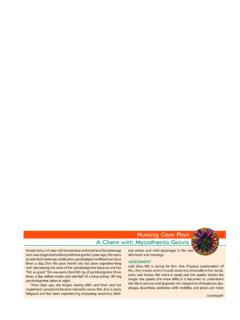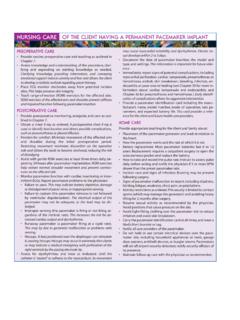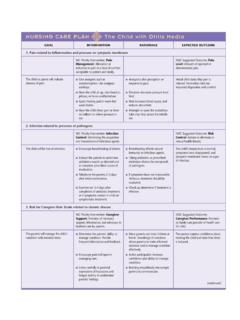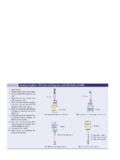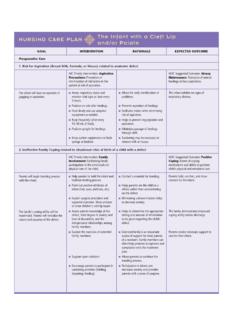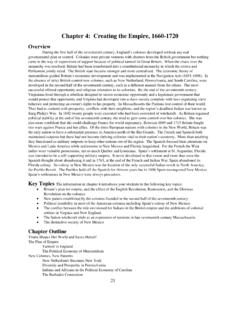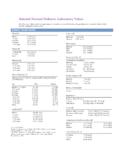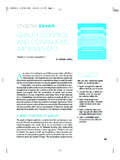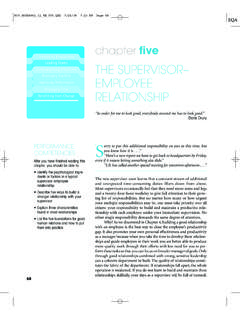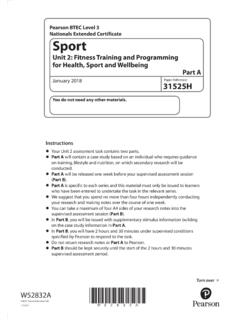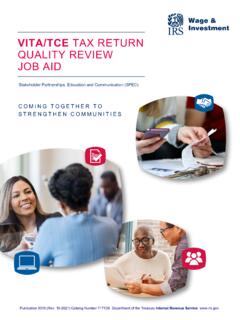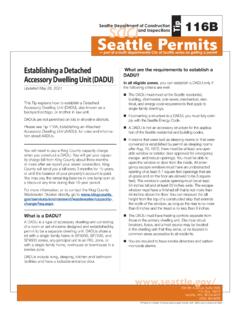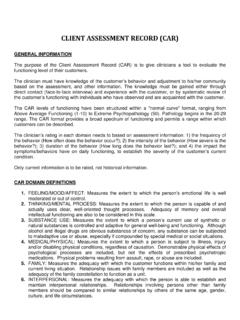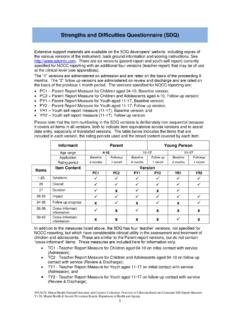Transcription of Nursing Care Plan A Client with Malnutrition
1 536 UNIT V / Responses to Altered NutritionHome CareClients with Malnutrition may be cared for at home or in thehospital with diet, enteral, or parenteral therapy. Each year, it ismore common to see clients managing tube feeding or TPN athome. Teaching for the Client and family includes the follow-ing topics. Diet recommendations and use of nutritional supplements Where to obtain recommended foods and nutritional supple-ments If continuing enteral or parenteral nutrition, how to (1) pre-pare and/or handle solutions, (2) add them to either the feed-ing tube or central line, (3) manage infusion pumps, (4) carefor the feeding tube or central catheter, (5) recognize andmanage problems and complications, and (6) how and whento notify the health care provider of problems.
2 THE Client WITH AN EATING DISORDERE ating disorders are characterized by severely disturbed eatingbehavior and weight management. Eating disorders are morecommon in affluent societies where food is plentiful. Womenare much more commonly affected than men. Anorexia ner-vosais characterized by a body weight less than 85% of ex-pected for age and height, and an intense fear of gainingweight. Anorexia nervosa affects about to 1% of womenin the United States. Bulimia nervosa,which affects 1% to 3%of women in the United States, is characterized by recurringepisodes of binge eating followed by purge behaviors such asself-induced vomiting, use of laxatives or diuretics, fasting, orexcessive NERVOSAA norexia nervosa typically begins during with anorexia nervosa have a distorted body imageand irrational fear of gaining weight.
3 They maintain weightloss by restricted calorie intake , often accompanied by exces-sive exercise. Some clients may exhibit binge purge behav-ior. A number of risk factors, both biologic and psychosocial,have been identified for anorexia nervosa. Abnormal levels ofneurotransmitters and other hormones may play a who develop anorexia nervosa tend to be obsessiveRose Chow is an 88-year-old widow who livesalone. She typically rises early and has a cup of teabefore spending her morning puttering in her garden. She con-sumes her main meal of the day at lunch, which usually includesrice and some vegetables.
4 For dinner, she generally eats a bowl ofrice with whatever seems to be in the refrigerator. She admits tolittle interest in cooking or eating since her husband died 10 yearsago and her group of friends has been dying off, too. ASSESSMENTMrs. Chow weighs 95 lb ( kg) and is 5 3 (160 cm) tall, for a BMIof She reports weighing 118 lb ( kg) 5 years ago. Her tri-ceps skinfold thickness measurement is 11 mm (normal valuesfor a female:>13 mm). Her skin is pale, and she appears thinand wasted. Her temperature is 97 F ( C). Diagnostic test re-sults include serum albumin g/dL (normal to g/dL)and serum cholesterol 130 mg/dL (normal 150 to 200 mg/dL).
5 Adiagnosis of protein-calorie Malnutrition is made, and a 1500-calorie per day diet is Imbalanced nutrition: Less than body requirements,related tolack of knowledge and inadequate food intake Risk for infection,related to protein-calorie Malnutrition Impaired social interaction,related to widowhood and re-duced social support groupEXPECTED OUTCOMES Gain at least 1 pound per week. Verbalize understanding of nutritional requirements andidentify strategies to incorporate requirements into daily dietafter discharge. Remain infection free, evidenced by normal vital signs.
6 Identify strategies to increase social interaction, such as partic-ipating in senior citizens lunches at local senior AND IMPLEMENTATION Weigh weekly at a consistent time of day. Refer to dietitian for evaluation of nutritional needs. Teach about nutritional requirements, and plan an eatingprogram that includes high-calorie, high-protein foods andsupplements and reflects her food preferences. Encouragesmall, frequent meals. Encourage to keep a food intake diary. Teach strategies to reduce risks for infection. Provide information about communal meals available to sen-iors in the community, and help Mrs.
7 Chow develop a plan month later, Mrs. Chow has gained 3 pounds and reportsfeeling more energetic. A friend is helping her shop to ensurethat she purchases foods to maintain her protein, calorie, and nu-trient intake . She has begun attending senior lunches twice aweek, and is enjoying being around people again. Althoughshe still doesn t enjoy cooking like she used to, she is using pre-pared foods and supplements to maintain her nutrient Thinking in the Nursing Process1. What is the physiologic basis for Mrs. Chow s low albumin andcholesterol levels?
8 2. Mrs. Chow asks, Can I get better by just taking more vita-mins? How will you respond?3. Design a teaching plan for a Hispanic Client with protein-calorie Evaluating Your Response in Appendix Care PlanA Client with Malnutritio

